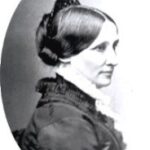Basic Facts:
Birth: October 4, 1822 at Delaware, Ohio
Death: January 17, 1893 at Fremont, Ohio
Married: Lucy Ware Webb (1831-1889) on December 30, 1852
Children: 8: Birchard, Webb, Rutherford, Joseph, George, Fanny, Scott, Manning
President: One term beginning March 5, 1877
Family
 Lucy Hayes was the first First Lady to have a college degree. She was also a more egalitarian hostess than previous First Ladies. An advocate for African Americans both before and after the American Civil War, Lucy invited the first African-American professional musician to appear at the White House.
Lucy Hayes was the first First Lady to have a college degree. She was also a more egalitarian hostess than previous First Ladies. An advocate for African Americans both before and after the American Civil War, Lucy invited the first African-American professional musician to appear at the White House.
Historians have christened her “Lemonade Lucy” due to her staunch support of the temperance movement; however, contrary to popular belief, she was never referred to by that nickname while living. It was her husband who banned alcohol from the White House.
Rutherford and Lucy had 8 children, 5 survived to adulthood. There are biographical sketches of each of them at the website of the Presidential Library.
- Birchard Austin (1853–1926),
- Webb Cook (1856–1934), He left Cornell to work as his father’s secretary when his father was the governor of Ohio. When his father was elected president, the son again served as his father’s secretary. In 1881, Hayes moved to Cleveland to work as the treasurer of the Whipple Manufacturing Company. In 1887, he, with three others, founded the National Carbon Company, which is now known as Union Carbide. Hayes stayed with this company for many years as the vice president. Hayes also served in the military in the Spanish–American War, Philippine–American War and First World War.
He was the principal proponent for founding the Rutherford B. Hayes Presidential Center, the first presidential library. It was established in 1916 at Spiegel Grove. - Rutherford Platt (1858–1927),
- Joseph Thompson (1861–1863), Hayes believed the cause of death was complications brought about by teething and dysentery.
- George Crook (1864–1866), Hayes described this son as “stout – and very pretty – the most promising of any child we have had.” George Crook Hayes died on May 24, 1866, from scarlet fever. Rutherford B. mourned the loss of this son deeply.
- Fanny (1867–1950),
- Scott Russell Hayes (1871–1923),
- Manning Force Hayes (1873–1874). died in infancy probably of dysentery.
Lucy died June 25, 1889 after suffering a stroke. She was 57 years old. Flags flew at half-mast in her honor.
Other
Joined Republican Party 1845 to oppose expansion of slavery
Served a single term as promised in inaugural
Of the five presidents who served in the Civil War, Hayes was the only one to be wounded. (Battle of South Mountain in Maryland)
In 1864, when Hayes was still on the battlefield defending the North, the Republican Party in Cincinnati nominated him for Congress. He accepted the nomination but refused to campaign. In a letter to his friend Ohio Secretary of State William Henry Smith (1833–96), Hayes explained, “An officer fit for duty who at this crisis would abandon his post to electioneer for a seat in Congress ought to be scalped.” Hayes left the army after the war ended in 1865, and in December of that year, having won the election, took his seat in the U.S. House of Representatives.
Resigned in 1867 to run for governor of Ohio – won and re-elected 1869-1872.
Elected governor again in 1875. Ran on voting rights for blacks and on economic plans for a strong gold-backed currency.
The presidential election of 1876 was one of the most contentious and controversial in American history, and is known for being the catalyst for the end of Reconstruction. Republican Rutherford B. Hayes faced Democrat Samuel Tilden. After a first count of votes, Tilden had won 184 electoral votes to Hayes’s 165, with 20 votes from four states unresolved: in Florida, Louisiana, and South Carolina, each party reported its candidate had won the state, while in Oregon, one elector was replaced after being declared illegal for being an “elected or appointed official”. The question of who should have been awarded these electoral votes is the source of the continued controversy. An informal deal was struck to resolve the dispute: the Compromise of 1877, which awarded all 20 electoral votes to Hayes (giving him a total of 185 to Tilden’s 184); in return for the Democrats conceding to Hayes’ election, the Republicans agreed to withdraw federal troops from the South, ending Reconstruction.
As president, Rutherford B Hayes ended Reconstruction within his first year in office by withdrawing federal troops from states still under occupation. He made federal dollars available for infrastructure improvements in the South and appointed Southerners to influential posts in high-level government positions. While these actions satisfied Southern Democrats, they also antagonized some members of Hayes’ own party.
Arriving in San Francisco on September 8, 1880, Hayes became the first president to visit the West Coast while in office.
Hayes was the first president to graduate from law school.
He signed the act that permitted women to plead before the Supreme Court.
The first White House telephone was installed, by Alexander Graham Bell himself, during the Hayes administration.
The first Easter egg roll on the White House lawn was conducted by Hayes and his wife.
Return to The Presidents main page.
Sources:
Internet Public Library
Rutherford B. Hayes Presidential Library.
Greenman, Barbara. The Timeline History of U. S. Presidents and First Ladies Thunder Bay Press, San Diego, California, 2009.
